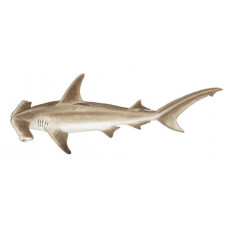Latin name
Sphyrna species
Other names
Hammerhead sharks
Identification
Hammerheads are easy to identify, even for the beginner: the eyes are located at the ends of two thin blades, and the general framework resembles a hammer. This shape is ideal for turning and detecting odors, allowing the best use of electroreceptors, which facilitates the detection of food. The smooth hammerhead has a rounded leading edge of the head and has no serrations in the center. The scalloped hammerhead is a gray-brown or olive shark. The scalloped hammerhead has the front edge of the head rounded and serrated, or has a scallop.
Distribution
Hammerhead sharks are found all over the world.
Habitat
The great hammerhead shark prefers warm waters and is rarely found outside tropical areas. The smooth hammerhead lives in shallow, calm coastal waters of bays and harbors.
Size
The largest species is the great hammerhead, which can reach a length of 20 feet and a weight of 1,000 pounds. The most widely distributed species is the smooth hammerhead, which grows to 14 feet. The scalloped hammerhead usually grows from 5 to 7 feet, but sometimes reaches 15 feet.
Life history and Behavior
Smooth, and scalloped hammerheads sometimes gather in large groups.
Food and feeding habits
Stingrays are believed to be the favorite food of many hammerheads.
Reproduction
All species are viviparous and prolific, giving birth to many live young at the same time.
| Classification | |
| Phylum | Chordata |
| Class | Chondrichthyes |
| Squad | Carcharhiniformes |
| Family | Sphyrnidae |
| Features | |
| Conservation status | No information |
| Habitat | Littoral |
| Life span, years | 35 |
| Maximum body weight, kg | 580 |
| Maximum length, cm | 600 |
| Sailing speed, m/s | No information |
| Threat to people | Edible |
| Way of eating | Predator |
Sharks, Hammerhead
Tags: Sharks, Hammerhead





